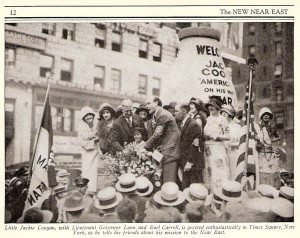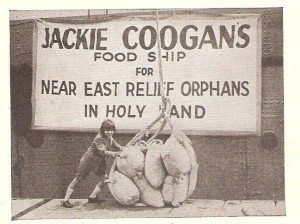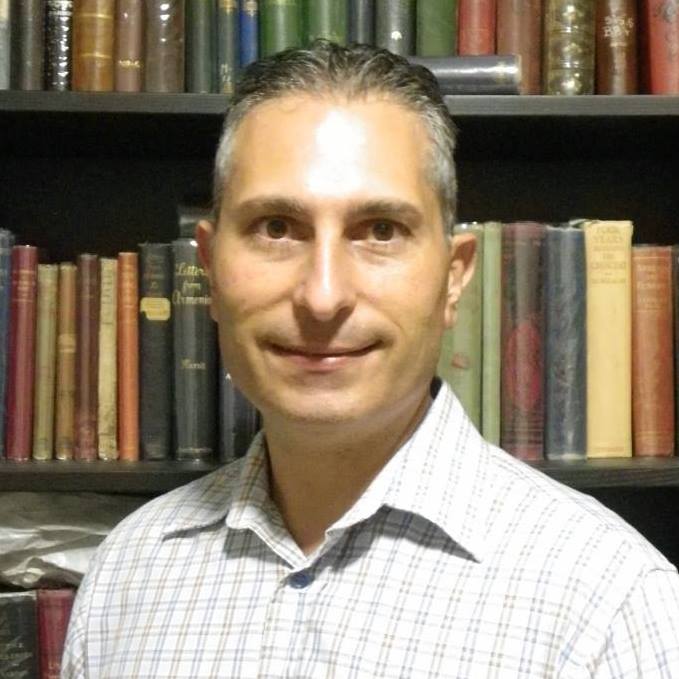A story that made the rounds in Hollywood in the 1960’s told of how a little girl who had been a fan of the TV series “The Addams Family” was lunching with her mother in a studio cafe, when she spotted the actor who played Uncle Fester. The girl excitedly approached the beefy 50-year-old man and asked him for his autograph. With a broad smile, he signed, “Jackie Coogan.” Studying the signature with great dismay, the little girl cried out, “Who’s Jackie Coogan? I have never heard of him! I wanted you to sign ‘Uncle Fester’!”1

While many of us will identify with the girl’s disappointment, the story is fraught with irony and represents the forgotten legacy of Hollywood’s first “celebrity humanitarian.”
Celebrity humanitarianism, which has gained such great momentum in recent decades, was brought to the spotlight in 2010 during the Emmy Awards Ceremony, when George Clooney was awarded the Bob Hope Humanitarian Award. Clooney is part of a growing trend of A-list stars who are advocating a plethora of humanitarian causes from war-torn regions in Africa to child labor in India. Audrey Hepburn, through her tenure as a UNICEF goodwill ambassador, is commonly attributed as beginning the current trend. Largely forgotten, however, is America’s first celebrity humanitarian—Jackie Coogan.
Jackie’s career as a child actor in silent films began with his role at the age of seven as Charlie Chaplin’s irascible sidekick in the 1921 film “The Kid,” and his role in Frank Lloyd’s “Oliver Twist” in 1922. It was a time when America was becoming an increasingly image-driven society and there was an insatiable hunger for entertainment. Dubbed “the most famous boy in the world” at the time, Jackie was also one of the first stars to be heavily merchandised with several products such as peanut butter, stationery, dolls, and records. It was during the pinnacle of his fame that Jackie, through his celebrity-hood, was recognized as being a potentially powerful and effective advocate for philanthropic causes.
In the wake of the Armenian Genocide during World War I, an American philanthropic organization called the Near East Relief (NER) had taken on the task of providing humanitarian aid to the survivors of the tragedy.2 Over a million destitute Armenian refugees and orphans in the Near East were in need of urgent relief. Their pitiful plight prompted Jackie Coogan, along with other members of the theatrical profession, to donate their unwanted clothing to the “million and half ragged, starving” Armenian refugees facing a bitter winter in 1921. This act of kindness caught the attention of the directors of the NER, who dubbed Jackie an “infant phenom” turned “philanthropist.”3

Recognizing the effectiveness of celebrity endorsements in mobilizing the general public towards humanitarian causes, the NER approached the Coogans requesting permission to enlist Jackie as part of an innovative fundraising strategy. In granting approval, Jackie’s father stated that he wanted “Jackie to see and realize some of the hardships and suffering other children of his own age have had to endure…to bring home to him a realization of the common duty of all mankind to one another.”4
In 1924, Jackie was commissioned by the NER to spearhead a modern “Children’s Crusade” throughout the U.S. in an appeal to the children of America for a million dollar shipload of foodstuffs for the destitute orphan children in the Near East. It involved an initial cross-country American fundraising junket, in his own private railroad car, ending in New York. Jackie proclaimed: “We who are in this Children’s Crusade of Mercy must do our best for these orphan children. We shall do for them as we should like to have them do for us if we were orphans. The Children’s Crusade must provide food for those inside the orphanage doors and relieve the sufferings of those outside.”5
In each town Jackie visited, he received an ovation prompted partly by admiration for the boy himself and partly by the enthusiastic approval of his mission. The mayor of Boston gave him the key to the city. In Brooklyn, August 16th was declared “Jackie Coogan Day” and over 100,000 boys and girls crowded the city’s park. In Albuquerque, N.M., he was made a Medicine Man of the Navajo Indians. The stations of every town through which his train passed were crowded to capacity by his admirers, both big and small. And almost everyone who came to greet Jackie brought with them gifts—cans and cases of milk, boxes and packages of food and money.6 Jackie’s tour received unprecedented media coverage in the U.S. through newspapers, movie magazines, and newsreels.

This national tour was followed by an Atlantic voyage to Europe in September where Jackie was greeted by enthusiastic crowds in London and Paris. While in Rome, Jackie had a private audience with the reigning pontiff, Pius XI, who gave Jackie his papal blessing and bestowed upon him a silver medal bearing the papal coat of arms, engraved in gold.7 His destination was Athens, which housed thousands of Greek and Armenian refugees. Jackie personally handed over the bills of lading for over $1 million (about $13 million in today’s terms) worth of relief cargo for distribution to the refugees and orphans.
In the presence of Greek and American dignitaries as well as over 7,000 orphans, Jackie was decorated by the Greek government with the Silver Cross of the Order of St. George, given in recognition of his humanitarian work.8
On his return to the U.S., Jackie was welcomed by the Governor of New York, Lieutenant George R. Lunn, and was enthusiastically greeted by huge crowds in Times Square. A moving picture on Jackie’s humanitarian journey was produced by the NER titled “Jackie in the Near East,” which was screened throughout the U.S. and across the world.
So while we continue to recognize the enormous contribution of today’s celebrity humanitarians in drawing attention to suffering humanity, let’s not forget the first celebrity humanitarian, Jackie Coogan.
Endnotes
1. Cary, Diana. Jackie Coogan: The World’s Boy King, The Scarecrow Press, Inc. Maryland, 2003, p. 15.
2. Established in 1915 in response to a telegram sent by the American ambassador to Turkey, Henry Morgenthau, the Near East Relief was eventually incorporated by an Act of Congress in August 1919. By 1929, the organization had raised over $100 million and had saved over a million Armenians and Greeks from starvation and disease. It was an unsurpassed achievement, remarkable even by today’s standards, accomplished through the pioneering of philanthropic techniques that continue to be used today.
3. “The ‘Infant Phenom’ Turns Philanthropist,” The New Near East, May 1921, p. 8.
4. “Jackie Coogan to Aid Tots,” Los Angeles Times, March 17, 1924, p. A2.
5. “The Golden Rule Crusade,” The New Near East, Near East Relief, September 1924, New York, p. 12.
6. The New Near East, September 1924, p. 13.
7. “Jackie Coogan Gets Audience With Pope,” The New York Times, Sept. 30, 1924, p. 18.
8. Coogan, Jackie. “My Visit to Athens,” The New Near East, Near East Relief, April 1925, p. 15.



A fascinating piece of research. Thank you, Mr. Babkenian.
What a wonderful piece of Americana/Armeniaca. Thanks, Vicken!
Here’s a thought:
Why is there no sizeable group of public figures, actors, and actresses, including Kim Kardashian (suitably informed) and Serj Tankian, who are as organized as other celebrity groups that take up causes such as the Sudan genocide, who take up Armenian issues? Hollywood and NY are filled with Armenians in show biz.
Wow what a great article , God bless you Vicken you are full of surprises, when it comes to the Armenian history, you make us so proud, and we are proud to say that you are our relative, you are unique from inside and out , keep up the great work you do and believe us that you are so much appreciated among fellow Armenians, and you are making all Armenians household known about you ! love you Vicken
Babikian family
SYdney Australia
OK We get it! You used to be in need and some famous people helped you, but what is holding you now, to go back to your land and built it the way you want so that you can help some of the less fortunate in return?
SVWTLANA:
SO, WHAT IS YOUR POINT?
Dear Svetlana
I don’t understand the purpose of your comment. There is nothing stopping us from going back and helping the less fortunate in Armenia. There are many Armenian/non-Armenian organisations and individuals who are helping the less fortunate in Armenia today. We can always do more. What’s your point got to do with Vicken’s article?
Thanks for an interesting article. For more on Jackie Coogan see http://en.wikipedia.org/wiki/Jackie_Coogan
Vicken, you have done it again!